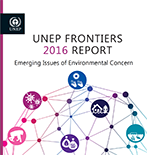The UN Environment Programme (UNEP) identifies six "emerging issues of environmental concern" in its 2016 Frontiers Report, released to coincide with the second session of the UN Environment Assembly (UNEA-2).
For each issue, the report provides examples of ways to address it, including through innovating and rethinking policy interventions, devising new solutions and adapting existing practices.
UNEA-2 is convening in Nairobi, Kenya, from 23-27 May 2016.
 20 May 2016: The UN Environment Programme (UNEP) identifies six “emerging issues of environmental concern” in its 2016 Frontiers Report, released to coincide with the second session of the UN Environment Assembly (UNEA-2). For each issue, the report provides examples of ways to address it, including through innovating and rethinking policy interventions, devising new solutions and adapting existing practices. UNEA-2 is convening in Nairobi, Kenya, from 23-27 May 2016.
20 May 2016: The UN Environment Programme (UNEP) identifies six “emerging issues of environmental concern” in its 2016 Frontiers Report, released to coincide with the second session of the UN Environment Assembly (UNEA-2). For each issue, the report provides examples of ways to address it, including through innovating and rethinking policy interventions, devising new solutions and adapting existing practices. UNEA-2 is convening in Nairobi, Kenya, from 23-27 May 2016.
According to ‘UNEP Frontiers 2016 Report: Emerging Issues of Environmental Concern,’ emerging environmental challenges include: the rise in zoonotic diseases (diseases that can be spread between animals and humans, and which include Ebola, bird flu and the Zika virus); increasing crop toxicity due to climate change; microplastic waste in oceans and its effects on human health; the potential role of the world’s financial sector in advancing sustainable development and a low-carbon, resource efficient future; illegal trade in live animals, including disease transmission; and loss and damage, and negative impacts of climate change on ecosystems.
On zoonotic diseases, the report finds that their rise is linked to human activities that encroach on natural habitats, enabling pathogens in wildlife reservoirs to spread. In the last two decades, emerging diseases have cost more than US$100 billion.
On crop toxicity, the report explains how drought and high temperatures can trigger the accumulation of toxic chemicals in crops, including wheat, barley, maize and millet, which can lead to acute nitrate poisoning in animals and other problems. Heavy rains that break droughts can lead to the accumulation of hydrogen cyanide or prussic acid in crops such as flax, maize, sorghum, arrow grass, cherries and apples. Maize at higher latitudes can be contaminated with aflatoxins, which can cause cancer and stunt fetal growth.
On microplastics, the report analyzes a number of studies that aim to determine the risks that the particles pose to human and ecosystem health. It notes that microplastic waste is being found in water systems throughout the world as well as in the stomachs of zooplankton, whales and other marine species.
The financial sector, according to the report, has an important role to play in investing in new, low-carbon, resource-efficient and environmentally sound assets, and in shifting capital away from assets that damage the environment. The report highlights specific financial initiatives, such as Unilever’s ‘Sustainable Living Plan,’ which pledges to cut the company’s environmental impact in half by 2020, while improving the health of one billion people.
On live animal trade, the report says that data on the scale and scope is limited, but “is clearly big business that attracts drug cartels, arms suppliers, counterfeit organizations, and a host of other illegal networks” and poses threats to species’ survival while exposing humans to zoonotic diseases.
Regarding climate change, the report reviews cases where recent, sudden and slow-onset events have caused losses and damaged ecosystems. It concludes that losses and damages are inevitable, with significant environmental socio-economic consequences anticipated. It also presents a range of tools to help mitigate such outcomes in the future. [UNEP Press Release] [Publication: UNEP Frontiers 2016 Report: Emerging Issues of Environmental Concern] [UNEP Knowledge Repository]